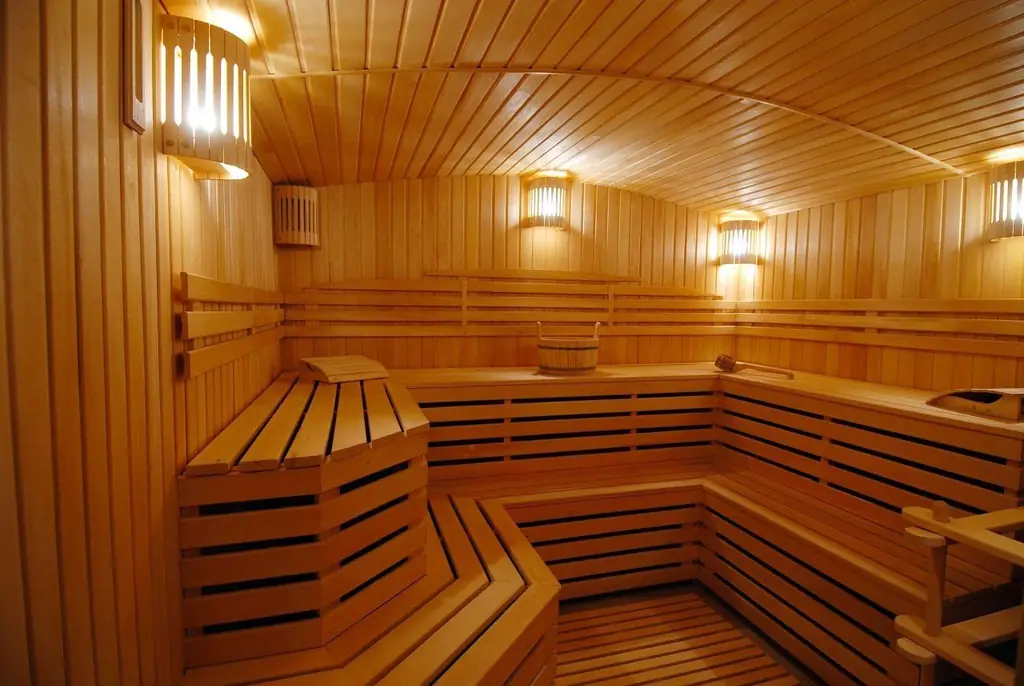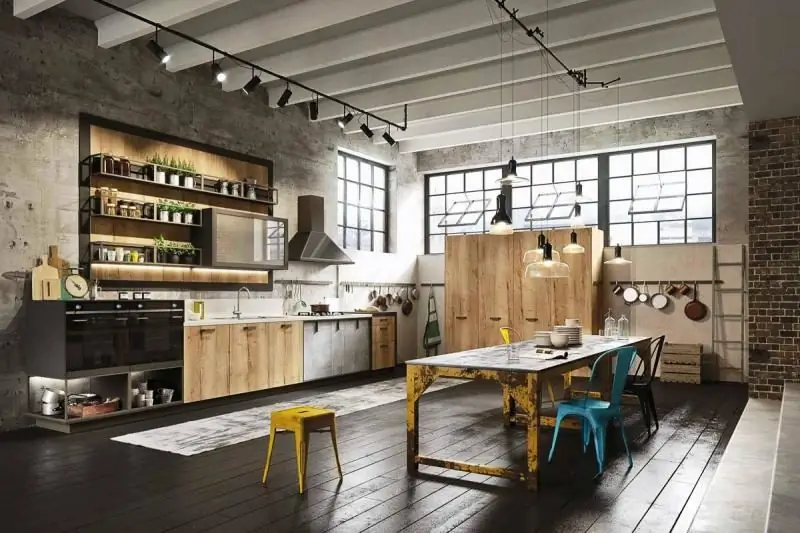
Table of contents:
- Author Bailey Albertson [email protected].
- Public 2023-12-17 12:53.
- Last modified 2025-01-23 12:41.
Decorating the bath from the inside with your own hands

After the construction of the bathhouse is completed, you should think about interior decoration. This is perhaps the most important work, since it includes heat, hydro and vapor insulation, which will ensure the correct functioning of the building. It depends on the interior decoration how comfortable your bath will be, and how pleasant you will spend time in it.
It is very important to consider step by step each element of the work on the internal arrangement of the bath in general and the steam room in particular. Any mistake at this stage in the future can turn into inconveniences that will be very difficult to fix.
Content
- 1 Requirements for warming a bath room
- 2 Preliminary preparation
- 3 More about skin layers
- 4 Installing a heat and vapor barrier layer
- 5 Steam room lining
- 6 Video about the interior decoration of the bath
Requirements for warming a bath room
The most important quality of the steam room is the preservation of hot steam and heat inside the room for a long time. That is why thermal insulation comes first in decoration. There are many methods for such work, but we will consider the simplest and most common, which are easy to do with your own hands, without resorting to the help of specialists.
When choosing materials for insulation, one should be guided by their safety at high temperatures usual for a steam room, that is, fire resistance and resistance to sudden temperature changes. The most common materials are rock wool as insulation and aluminum foil as vapor barrier. They are distinguished by high reliability and ease of use.
Before starting work on the insulation of the walls of the bath, the surfaces should be carefully prepared. Examine the walls and ceiling carefully, remove gaps, knots, roughness. All wooden surfaces are treated with an antiseptic, which will provide protection against mold and mildew.

Insulating and equipping the bathhouse, you will get the walls in the form of a so-called "sandwich", consisting of layers alternating in a certain sequence: a waterproofing layer, insulating, vapor-insulating, and, finally, an inner lining.
Preliminary preparation
As you know, the main thing in a Russian bath is a properly installed stove. It needs to be built before you can tackle the interior. And in this case, it is better to turn to the help of a professional stove-maker, who will determine where the hearth should be, set the correct direction of the bends and build the body.
Installing a traditional brick or stone stove will require special attention to features such as the soil on which the bath is built, the foundation, the materials used in the walls, the type of roof, and even the climatic conditions of the area. To make things much easier for yourself, you can turn to modern technology. On the construction markets and in specialized stores, there is a huge selection of boilers and stoves, which in their functionality are in no way inferior to the classic stone bath stove, but in comparison with it, they are completely safe, and also economical and easy to use.

Such a heating device does not require special skills from you, you can install it yourself, or with the help of a specialist, and rather quickly and without subsequent cleaning of the accumulated construction waste. Manufacturers provide buyers with a complete set of necessary equipment and additional devices.
After the oven is installed, install the electrical wiring, ensure its insulation and the necessary leads, and then proceed directly to the interior decoration.
Learn more about skin layers
Insulation of the walls of the bath, and especially the steam room, should begin with a layer that provides waterproofing. It will help to avoid the formation of condensation on the outer walls when in contact with hot air and constant temperature changes. You should pay special attention to any possibility of dampness on the walls: the occurrence of mold and mildew not only adversely affects wooden surfaces, up to rotting, but can also have a harmful effect on your health.
The most commonly used waterproofing materials are foil or plastic sheeting. Stretch evenly measured parts of the material from the roll, leaving allowances of about 10-15 cm, carefully stretch the film or foil sheet to avoid tears and damage, and fix them with a construction stapler. At the junctions of individual sheets, there should be an overlap of 10-15 cm, which will not allow moisture from the outside to enter the gap and settle on the insulation layer.

After the waterproofing of the walls, floor and ceiling is completed and all possible gaps are closed, proceed with the installation of the thermal insulation layer. To begin with, sheets of clean, thoroughly dried paper are attached to the surface. To keep the loss of hot air to a minimum, the sheets should be fastened with a sufficiently large overlap.
After that, a pre-fabricated frame is installed on the surface to be insulated. For it, you will need wooden blocks with a cross section of 50 X 50 mm, properly impregnated with an antiseptic. The spacing between the bars must exactly match the width of the roll of material being used.
A few words about the choice of thermal insulation material. In the modern construction and repair market, you can find a lot of options for various properties, quality and price category. But until now, the most widespread and demanded is mineral wool. Synthetic soft boards are also gaining popularity. These inorganic materials are durable, fireproof, do not absorb moisture and subsequent decay, and also do not interest small rodents and insects.
Installing a heat and vapor barrier layer
The thickness of the layer of insulating material directly depends on the design of the insulated surface. It should be noted that the floor of the bath, both wooden and concrete, is insulated according to a certain technology, and this work is laborious enough to devote a separate article to it. Now we are considering the insulation of the walls and ceiling of a traditional wooden bath.
The ceiling is subject to much more thorough insulation than the walls, so the layer of mineral wool on it should be twice as thick. This is due to the fact that the hot air in the steam room rises, and it is through the ceiling that the maximum heat loss occurs.
So, the frame previously made of beams is installed on the surface and carefully fastened with self-tapping screws or bushings. An even cut of insulating material is placed in a step between the bars. It should fit tightly, without free spaces and overlaps. The edges of the material are fixed with a construction stapler.
At the end of the laying of mineral wool, the time comes for the next stage - vapor barrier. Aluminum foil is most often used in this capacity, since it not only protects the insulation from steam and moisture, but also has reflective properties. Thanks to this quality, the foil creates in the steam room the so-called "thermos effect", which retains heat inside the room for a long time.

So, to install a vapor barrier layer, you will need:
- Aluminum foil in the required amount;
- Thin slats for lathing;
- Small wallpaper nails or construction stapler;
- Scotch tape or duct tape.
For vapor barrier, it is preferable to take a foil with a thickness of 65 microns. This material is optimal in terms of density and strength, which is easy to work with.
First of all, you should prepare the crate. Since the room of the bath and steam room is small, it will be easy to make the crate by stuffing the slats to the frame of the insulating layer.
After that, sheets of foil are fixed to the crate with wallpaper nails or a stapler. However, they should be well, but not too tight and carefully aligned. The overlap of the sheets on each other should not be more than 5 cm. Since the vapor barrier layer must be continuous, the sheets are connected at all joints with adhesive tape.
The main condition for the materials used: they must be environmentally friendly, and when exposed to heat and moisture, they must not emit extraneous odors of a chemical nature. That is why such common building materials as roofing felt, roofing felt or glassine are not used in the interior decoration of the bath.
Steam room lining
After the "sandwich" of hydro, heat and vapor insulation is ready, we proceed to the final stage - facing the walls and ceiling in the room with lining. Traditionally, natural wood is chosen for cladding, mainly hardwood, such as linden, maple, aspen and alder. These materials are optimal in terms of quality, properties, and, moreover, their price is low. Softwood planks can release tar when exposed to heat, which is unpleasant for the skin. If, after all, the coniferous aroma in the bath is very important for you, then choose cedar. It has high density and low resin content.

When choosing a material for lining, adhere to the following requirements:
- The high density of wood will provide resistance to high humidity and protection from decay;
- Lowest or no resins as much as possible;
- The surface of the board must be absolutely smooth, without gaps and knots;
- The wood should have low thermal conductivity, that is, it should not heat up too much, so as not to cause burns on the skin.
Install a frame made of bars on the mounted vapor barrier layer, which will hold the lining on itself. After that, fill the boards one by one, carefully adjusting them with a wooden mallet. For fixing, you can use nails or self-tapping screws, the main condition is that the caps must be recessed into the surface, so that later lovers of bath procedures do not get hurt in the process.
Usually, the location of the lining when sheathing is horizontal or vertical. The vertical method is simpler and can be applied in any direction. When using the horizontal method, the lining should be stuffed from the bottom up to prevent water from entering the joints and grooves.
Most often, the lining is fastened in a secret. For this, grooves are cut on each board, which are superimposed on each other. This will provide a tighter fit, which means protection from moisture and temperature changes for the insulation layers and the inner surface of the lining.
Video about the interior decoration of the bath
After all the stages of arranging your bath are completed, the final touch remains - creating a comfortable and cozy interior. This is a great excuse to show your imagination, so that later your vacation will give you exceptional pleasure, and bath procedures are not only aesthetic, but also health-improving. We wish you a light steam!
Recommended:
How To Make Lighting In The Bath With Your Own Hands (including In The Steam Room)

Detailed and step-by-step instructions for conducting electrical wiring and setting up lighting in bath rooms. Required materials, work features
How To Make A Steam Generator For A Bath (steam Gun) With Your Own Hands - Step By Step Instructions With Photos, Drawings And Video

How to make a steam generator and a steam gun for a bath with your own hands. Description of the device and its features. Instructions for creating a structure
Do-it-yourself Steam Room - Step-by-step Instructions On How To Create With Photos, Sizes, Device And Video

Steam room and its device. The choice of material for the device of a steam room, step-by-step instructions for the construction and interior decoration of the room with your own hands
Do-it-yourself Installation Of Interior Doors, As Well As What Tool Is Required To Carry Out The Work

Types and methods of installing interior doors. The order of work when installing doors. Tools and supplies. Features and nuances of installing fittings
The Interior Of The Kitchen And Living Room In A Loft Style In An Apartment And A Country House: Examples Of Design Design, Choice Of Color And Material, Decoration, Photo

The main features of the loft style and how to decorate the kitchen in such a design. The choice of materials, colors and textures for finishing. Loft-style lighting and decor for the kitchen
